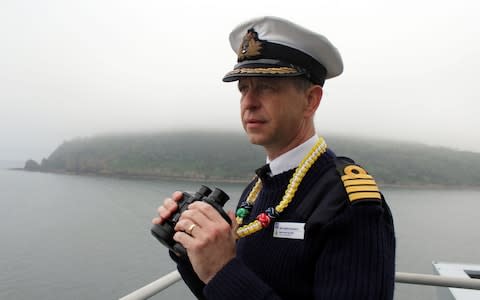Britain's Biggest Warship review – a smidgen more inquisitiveness might not have gone amiss

The most underwhelming thing about Britain’s Biggest Warship (BBC Two) was the gargantuan tub itself. HMS Queen Elizabeth might be taller than Nelson’s Column, with sufficient engine capacity to power all of Swindon (or Aberdeen, if you’d rather a Scottish comparison). But, heavens, the mammoth aircraft carrier – three times larger than predecessors HMS Ark Royal and Illustrious – cut a joyless figure as it underwent final pre-launch preparations at Rosyth dockyard on the Firth of Forth.
Looming in the murk Royal Navy's £3.1 billion new flagship was a ruthless triumph of function over form – a gunmetal lump with a runway that culminated in what resembled an outsized speed bump, as if the worst it might encounter patrolling the world’s hotspots was the occasional boy racer.
Happily, part one of Chris Terrill’s three-hour docudrama chronicling the birth pangs, such as they were, of the navy’s most ambitious ever engineering feat was considerably more charming than the dour dreadnought. Helping hugely was the fact that ship’s captain Jerry Kyd, our eyes and ears for the bulk of the episode, was a likeable sort who took a harpoon to seadog archetypes.
Quietly spoken with unflappable manner, Kyd was more Captain Mild than Captain Bligh. He said things like “the world at the moment is pretty frisky” and had the air of a details-oriented middle manager. It was hard to imagine him strapped to the tiller yelling “torpedoes away” (or whatever it is you shout when taking an aircraft carrier taller than Nelson’s Column into battle).

Kyd nonetheless had his work cut out getting the Queen Elizabeth literally ship shape in time for its mid -2017 launch date. One quarter of those setting off on her maiden voyage had never previously been to sea (bit of a setback if you’re a sailor presumably). Plus, health and safety regulations were understandably rigorous. A fire breaking out on deck needed, for instance, to be attended to within 30 seconds and extinguished within 60.
Complicating the puzzle, the Queen Elizabeth’s groundbreaking design involved the hulking twin propellors being driven by power diverted from the engines via electric cable. This, as Kyd might say, was a “frisky” proposition, given that water and electricity tend not to get on terribly well – especially with humans added to the equation.
And so it proved as, during a simulation of life at sea, the Queen Elizabeth sprung a leak in the engine room – sending what looked like gallons of saltwater gushing eagerly down onto all those electrics.
The crisis wasn’t overplayed by Terrill, who had in 2007 been awarded an honorary green beret when embedded with Royal Marine Commandos training for Afghanistan (an experience chronicled in Commando: On The Front Line) . But you could sense the adrenaline as an alarm blared suddenly, prompting a mad, shaky-cam dash into the bowels of the boat as the crew rushed to contain the emergency (which they did, without undue fuss).
Britain’s Biggest Warship was an old-school fly-on-the-wall documentary, with Terrill there to quietly bear witness rather than act as pitbull interrogator. No doubt this helped foster a bond between film-maker and his subjects.

However, it also left some questions dangling in the wind. There was, in particular, a lack of follow-through as it was explained that the new flagship used a “lean manning” model, meaning it was crewed by less than 700 rather than the 3,000 required to run an American carrier of equivalent size.
“Lean manning is not just about efficiency of course,” elaborated the narrator, “but about saving money as defence budgets continue to bite”. For penny-pinching to be a key design principle of the Royal Navy’s posterchild came as an eye-opener – as did the revelation that the missile system utilised delivery logistics similar to that employed by Amazon at its warehouses.
That Britain’s naval prestige was being entrusted to a vessel dependent to technology comparable to that used to deliver Mad Men boxed sets was, on the face of it, disconcerting. Here and elsewhere, a smidgen more inquisitiveness might not have gone amiss.

